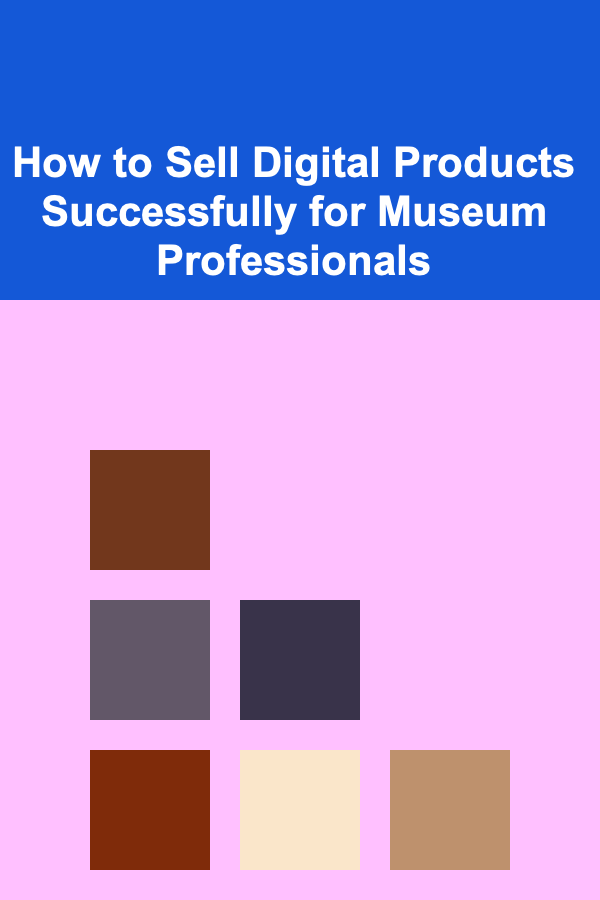
How to Sell Digital Products Successfully for Museum Professionals
ebook include PDF & Audio bundle (Micro Guide)
$12.99$7.99
Limited Time Offer! Order within the next:

In the age of digital transformation, museums have started to explore new ways of engaging with their audiences. Digital products, ranging from eBooks and virtual tours to interactive courses and downloadable artwork, offer exciting opportunities for museums to generate revenue, broaden their reach, and enhance visitor engagement. Selling digital products is not just about creating an online store and waiting for sales to roll in. It requires a strategic approach that aligns with the museum's mission, attracts the right audience, and optimizes for both user experience and long-term sustainability.
This actionable guide will outline practical steps and strategies for museum professionals looking to sell digital products successfully. Whether you are a museum curator, digital marketing expert, or someone passionate about blending art and commerce, the following insights will help you maximize the potential of your digital product offerings.
Understand Your Museum's Audience and Needs
The foundation of any successful product is understanding your audience. For museums, the audience can be diverse, including art lovers, history enthusiasts, students, educators, tourists, and local residents. Each of these groups may have different interests, goals, and technological capabilities.
1.1 Define Your Audience Segments
Start by segmenting your audience. Consider the following groups:
- Local Visitors: People living near the museum who might be interested in supporting your institution through digital purchases.
- Global Visitors and Tourists: International audiences who may never visit in person but have an interest in your museum's collections.
- Educators and Students: Teachers looking for educational tools, or students conducting research.
- Art and History Enthusiasts: Those deeply interested in specific exhibits, artists, or historical periods represented by your museum.
1.2 Assess Their Needs
Different segments will be interested in different types of digital products. For example, an art lover might be interested in high-resolution digital prints, while a student may prefer a digital guidebook or a course based on the museum's exhibitions.
Use surveys, website analytics, and social media insights to understand what your audience is looking for. This research is crucial in shaping your digital product offerings.
Develop the Right Digital Products
Once you've identified your audience's needs, you can develop a range of digital products that will resonate with them. Below are several digital product ideas that can be particularly relevant for museums:
2.1 Digital Artworks and High-Resolution Images
Offer downloadable, high-resolution images of artworks from your collection. Many art lovers appreciate the opportunity to bring a piece of history or a favorite artwork into their homes. Offering various formats---such as wallpapers, prints, and even virtual frames---can make these items more accessible.
2.2 Virtual Tours
A virtual tour allows people to explore your museum from anywhere in the world. These can range from simple video tours to immersive 360-degree experiences. Virtual tours offer an engaging way for audiences to experience the museum when they can't visit in person.
2.3 Online Educational Courses and Webinars
Leverage the expertise of your curators and educators to create online courses, webinars, or virtual lectures on the topics that your museum covers. This could range from a lecture on a specific artist's work to a broader course on art history or preservation practices.
2.4 E-books and Digital Publications
Many museums produce scholarly articles, exhibition catalogs, and research papers. Offering e-books of these publications can provide a valuable resource for students, researchers, and enthusiasts. This also allows museums to monetize their academic and curatorial work.
2.5 Interactive Experiences and Apps
Develop interactive products, such as mobile apps or augmented reality (AR) experiences, that enhance the in-person museum experience. For example, an app that provides in-depth information about specific artworks or an AR tool that lets users interact with the museum's artifacts digitally can be highly appealing to tech-savvy visitors.
2.6 Merchandise and Collectibles
While not strictly "digital" products, you can offer digital versions of museum-related merchandise like digital postcards, themed filters, and exclusive access to behind-the-scenes content. These items appeal to those looking to remember their visit or support the museum online.
Build an Easy-to-Use E-Commerce Platform
Once you have a lineup of digital products, it's essential to have a user-friendly, secure platform where your products can be sold. An e-commerce platform will allow customers to browse your digital offerings, make secure payments, and download their purchases.
3.1 Choose the Right Platform
There are many e-commerce platforms that cater to selling digital products, such as:
- Shopify: Popular for its ease of use and customizable options, Shopify can handle both physical and digital products.
- Etsy: If your museum produces artwork or craft-related digital products, Etsy can be an excellent marketplace with a built-in audience.
- Gumroad: A simple solution for selling digital files, particularly if you have a smaller inventory.
- WooCommerce (WordPress): For museums with existing WordPress websites, WooCommerce is an excellent option for integrating digital sales into your site.
Ensure that your platform can support various file types (e.g., PDFs, image files, videos, etc.), offer secure payment options, and allow for easy product delivery after purchase.
3.2 User-Friendly Design
Your website or online store should be visually appealing and easy to navigate. Make sure it reflects the museum's brand identity and gives visitors an intuitive shopping experience. Features to prioritize include:
- Simple and clear navigation menus
- High-quality images of products
- A secure, streamlined checkout process
- Quick download access for digital products
- A responsive design for mobile users
3.3 Content Management and Delivery
Automated delivery systems can simplify the process for both you and your customers. After a purchase is made, the platform should automatically send a download link or provide access to the product. If selling courses or virtual tours, consider integrating platforms like Teachable or Thinkific, which specialize in hosting educational content.
Market Your Digital Products
Creating the right products and setting up an online store is just the beginning. Effective marketing is critical to attracting customers and generating consistent sales.
4.1 Leverage Your Museum's Existing Audience
Your museum likely already has a strong local or global following through its physical location, social media channels, or email newsletters. Use these platforms to build awareness of your digital products:
- Email Newsletters: Regularly update your mailing list about new digital products and exclusive offers.
- Social Media: Share engaging content like previews, behind-the-scenes footage, or user-generated content to attract interest. Visual platforms like Instagram, Pinterest, and TikTok can be particularly effective for museums.
4.2 Offer Special Promotions
Attract customers with limited-time discounts, bundle offers, or exclusive content. For example, you might offer a special discount for museum members or a package deal that includes multiple digital products (e.g., a virtual tour and an eBook).
4.3 Collaborate with Influencers or Bloggers
Partner with influencers in the arts, history, or education sectors to promote your digital products. These partnerships can significantly boost your museum's visibility, especially if the influencer shares a passion for the museum's themes.
4.4 Search Engine Optimization (SEO)
Invest in SEO to make your digital products easily discoverable by people searching for museum-related content. Focus on keywords relevant to your niche (e.g., "virtual museum tours," "art history eBook") and optimize product descriptions and content to rank higher in search results.
4.5 Content Marketing
Create blog posts, videos, and podcasts that highlight the unique aspects of your digital products. For example, a blog post detailing the creation process of your digital artwork or a podcast interview with curators can generate interest in your offerings.
Customer Support and Engagement
Once the sales are made, customer engagement doesn't stop. Providing excellent customer service is key to ensuring repeat business and positive word-of-mouth.
5.1 Provide Clear Instructions
Make sure customers can easily understand how to access and use their digital products. For example, include clear download instructions and provide troubleshooting tips for common issues.
5.2 Offer Post-Sale Support
Have a dedicated support system in place to handle any issues, whether technical difficulties with downloading products or inquiries about additional offerings. Offering excellent customer service can turn one-time buyers into long-term supporters.
5.3 Encourage Reviews and Testimonials
Positive reviews and testimonials can help build trust and attract new customers. After a successful sale, encourage buyers to leave a review or share their experience on social media. You can also incentivize reviews by offering a discount on future purchases.
5.4 Keep Your Audience Engaged
Stay in touch with your customers by providing updates on new digital products, museum events, or upcoming collaborations. This can keep your audience interested and engaged long after they've made their first purchase.
Conclusion
Selling digital products presents an exciting opportunity for museum professionals to expand their reach, diversify revenue streams, and create meaningful interactions with both local and global audiences. By understanding your audience, developing the right products, setting up a user-friendly platform, implementing effective marketing strategies, and maintaining excellent customer relationships, museums can successfully enter the digital marketplace.
The key is to view digital products not as an isolated revenue source but as an extension of your museum's mission to educate, engage, and inspire. With the right approach, your digital products can enhance the visitor experience both inside and outside the physical museum walls, making art and culture more accessible to a wider audience than ever before.

10 Affordable Options for Pet Grooming and Vet Care You Can Trust
Read More
How to Highlight Architectural Features When Staging My House
Read More
How to Make a Checklist for Event Registration and Ticketing
Read More
How to Invest in SPACs (Special Purpose Acquisition Companies)
Read More
Implementing Value-Based Pricing for Profit
Read More
10 Tips for Houseguest Preparation: Eco-Friendly Edition
Read MoreOther Products

10 Affordable Options for Pet Grooming and Vet Care You Can Trust
Read More
How to Highlight Architectural Features When Staging My House
Read More
How to Make a Checklist for Event Registration and Ticketing
Read More
How to Invest in SPACs (Special Purpose Acquisition Companies)
Read More
Implementing Value-Based Pricing for Profit
Read More